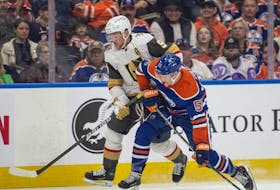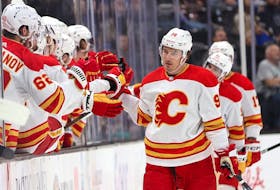Whether the American Hockey League is actually going to play games this season remains a bit of an open question.
If the AHL doesn’t operate in 2020-21, there’s been chatter among minor leaguers that NHL teams will mimic the set-up Major League Baseball teams used this year to stay prepared for injuries on the big league roster: host a large group of players who would normally play in the AHL in a nearby locale, not playing games but at least keeping something close to game fit.
Each NHL team’s training group could number as many as 15 skaters and goalies, one source told Postmedia News.
That would still leave a large number of AHLers looking for work. In other years, that might mean looking for work in the ECHL, the minor league that sits a level below the AHL.
Unlike the AHL, the ECHL is getting ready to actually play games in the coming months.
On the same day as the opening of NHL free agency, Oct. 9, the ECHL announced that they were going to have a two-pronged launch to the season.
Allen (Tx.), Florida, Greenville (S.C.), Indy (Ind.), Jacksonville (Fla.), Kansas City (Mo.), Orlando (Fla.), Rapid City (S.D.), South Carolina, Tulsa (Ok.), Utah, Wheeling (W.Va.) and Wichita (Kan.) all will start the season Dec. 11.
You’ll note those teams all play in states with Republican governors, where pro sports have been authorized to have limited — or in Florida’s case, full — capacity crowds in attendance.
Apparently an ECHL team needs about 30 per cent capacity, give or take, to break even on a season. That depends on the size of the arena for instance: Tulsa’s barn, the BOK Center, seats 19,199, while Idaho’s CenturyLink Arena in Boise seats just 5,002 for hockey.
The rest of the league remains up in the air. Teams are being allowed to opt-out — two already have, Atlanta and Norfolk (Va.) — and those that chose to play will begin their season Jan. 15.
Alongside Idaho in the still-to-decide pile are Kalamazoo — the Canucks’ Michigan-based ECHL affiliate, where prospects Jake Kielly, Josh Teves and Mitch Eliot made appearances last season — Fort Wayne, Toledo, Cincinnati, Worcester, Adirondack, Maine, Brampton, Reading and Newfoundland.
Given everything we know, it seems unlikely either Brampton or Newfoundland will play in Canada this season, meaning either they opt-out completely or perhaps end up playing in an American locale for the season.
Worcester is in Massacheusetts, Adirondack is in New York and Maine is in, well, Maine. All three of those states aren’t allowing large gatherings indoors, so it feels safe to say that those three teams won’t play either. Same for Reading, in Pennsylvania.
Those six teams make up the ECHL’s North Division, by the way.
Idaho, you’d assume, would need approval for at least 50-per-cent capacity, given the size of their arena. And even then you wonder if they could really operate with just 2,500 fans in attendance.
Kalamazoo, which plays in the Central Division, along with rivals in Fort Wayne, Toledo and Cincinnati, all in Ohio, face similar uncertainty over their ability to play. As it stands both those states aren’t allowing large gatherings. ( If football fans can’t attend Ohio State games , what chance does minor-league hockey have in Ohio!?)
Teams have been signing players all the while, but the players on the teams who haven’t yet opted in are surely nervous. Players who were signed to contracts by Atlanta and Norfolk have been made free agents, but there aren’t many jobs left on other teams.
And the uncertainty surrounding the AHL’s start to the season only complicates the player pool: ECHL teams are going to be interested in bringing in AHLers if the can, for obvious competitive purposes.
That said, ECHL teams are only allowed to dress four players with more than 260 games in professional hockey, so even if an AHLer came looking for a contract, there aren’t likely to be many spots available.
That’s going to put a lot of players in a real bind this season. The window to find a place to play in Europe is rapidly closing, if not already closed.
These guys play the game for the love of it. And they could be stuck with nowhere to go.
Copyright Postmedia Network Inc., 2020









